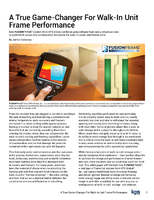Pasteurization System features energy efficient design.
Press Release Summary:
Swing pasteurizer has single heat exchanger for all pasteurization zones and no buffer, so no standby tank is needed to act as energy reserve. Also conserving energy is ring-shaped circuit, through which water passes and is kept at constant temperature by exchanger, before being distributed to different areas, and rain deviation system that keeps hot and cold water separate. Piping is positioned below water level in tanks, simplifying access to pumps, valves, and probes for safe maintenance.
Original Press Release:
"Swing," An Innovative Pasteurization System
Carlsberg UK invested on this break-through technology. Goal: Optimizing final product quality while minimizing consumption up to 25%.
Pasteurization technology takes a new turn with the introduction of Sidel's "Swing," a new system that cuts energy consumption by 25%. The new design (patent pending) was created in the company's R&D labs, in Verona, in response to the market's growing demand for sustainable solutions. As you are reading this, work is underway on the installation of Sidel's innovative Swing pasteurizer at the Carlsberg UK plant in Northampton, UK.
The evolution and development of Swing, an innovative custom solution
The new pasteurizer's outstanding feature is a single heat exchanger for all pasteurization zones, rather than one for each zone as in the past. Unlike the systems currently available on the market, Swing has no buffer, meaning no standby tank to act as an energy reserve. Sidel's system simply has a single ring-shaped circuit, through which water passes, kept at a constant temperature by an exchanger, before being distributed to different areas as required. This prevents waste of energy (as when heating a mass of water only to leave it to cool at the end of the production cycle) and ensures greater reactivity (treating only the amount of water required by different zones). As Carlsberg UK Project Manager Martin Essex states: "We were very impressed with the new technology. In fact, it's so simple it's difficult to understand why this idea has not been thought of before."
The second, even more important, new development is the presence of a rain deviation system in the various central areas. Hot and cold water never mix in this system; the "rain" that crosses the product at a given temperature is returned to the tank from which it was taken. With Swing, it is therefore possible to establish exactly where the water will be collected, deviating its path with a mechanical device. The goal is to keep the tanks at the required temperatures so that the water can be reused offering significant benefits in terms of costs and consumption. The Carlsberg UK Project Manager adds: "With energy and water being so expensive these days and the promise of using a lot less of both, we see this as an opportunity to vastly reduce those costs."
Furthemore, the only thermal energy required by the entire pasteurization process is the energy needed to heat or cool the product, not the masses of water contained in the process tanks, which are kept at their operating temperatures. Mr Martin Essex adds, "From a TCO point of view, the operating cost figures look good so it gives us an opportunity to reduce our energy consumption figures."
And so it is clear that all these changes mean effective, concrete, measurable energy savings. That's not all: greater control over heat treatment means a higher quality finished product. Swing, in combination with the UP PRINCE (PRediction IN Control Equations) control system, a software system (patent pending) to control Pasteurization Units (PU: equal to the effect of the product being kept at a temperature of 60°C for one minute.), permits optimization of the process, making it similar to operating conditions. The result is precise control of PUs, which determine the quality of heat treatment of the product and protection of its flavor and aroma.
The pasteurizer with the Swing system also has a number of useful technical features that make it extremely compact: positioning the piping below the water level in the tanks permits easy access to pumps, valves and probes for safe, easy maintenance. "We do not have masses of pumps, pipework and auto valves across the top of the pasteurizer which makes access for maintenance a lot easier and safer" underlines Mr Essex.
About the Sidel Group
With more than 30,000 machines installed in 190 countries, the Sidel Group, headquartered in Switzerland, is one of the world's leaders in beverage packaging solutions: covering water, carbonated soft drinks, milk, sensitive beverages, oils, beer and alcoholic beverages. Sidel Group has production sites in 13 countries as well as sales and service offices in 30 countries.
Around the world, the Group's approximately 5,000 employees provide customers with complete bottling solutions, including package design, line engineering, packaging machines and related services Innovation and Performance - the sustainable way.
To learn more about Sidel, come visit our Website: www.sidel.com.




